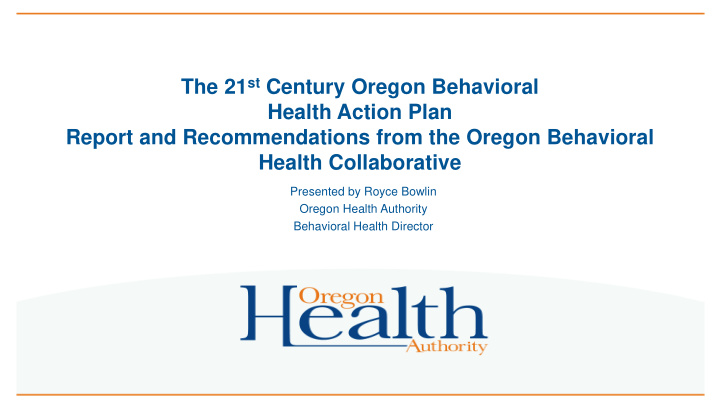



The 21 st Century Oregon Behavioral Health Action Plan Report and Recommendations from the Oregon Behavioral Health Collaborative Presented by Royce Bowlin Oregon Health Authority Behavioral Health Director
A unique opportunity Most states, while aggressively pursuing strategies to address mental health and substance use, are doing so on the back of new programs, payment models, and policy decisions. Rarely do states have the opportunity to make transformative systems changes that bring mental health and substance use seamlessly into the fabric of care delivery 2
Behavioral Health Collaborative OHA Director Saxton convened the Behavioral Health Collaborative (BHC) in July, 2016 with the goal of charting a course for excellence and sustainability in behavioral health services across systems. With an emphasis on cross-system coordination and collaboration, the BHC recommendations define policy, financing, and infrastructure needs to modernize and integrate the behavioral health system with individuals and families at the center and quality client outcomes as the goal. 3
Behavioral Health Collaborative membership Membership was determined through an application process. Expertise includes: peers, consumers, Tribal health care, behavioral health providers, prevention, education, corrections, public safety, housing, judicial, disability services, Coordinated Care Organizations (CCOs), and Counties. 4
Our approach Methods matter 5
Fragmented financing, delivery systems, and services fail to serve and exacerbate poor health outcomes for children, adolescents, adults, and older adults. • Access to behavioral health services, both specialty and general, do not meet the needs of all Oregonians in the right places at the right times in a culturally and linguistically specific manner • Continuum of care, service integration, and coordination between the systems of criminal justice, human services, health, and education is insufficient, administratively complex, and lacking in strategies addressing prevention for all populations. • Social determinants of health, including insufficient housing, employment, and transportation, create barriers to behavioral health resources that vary by community. • Oregon is not achieving the Triple Aim. 6
Overview Four DRAFT recommendations that builds the vision for a 21 st century behavioral health system that creates a results-driven model to improve outcomes for Oregonians living with behavioral health issues and to be financially sustainable for Oregon citizens.
Behavioral Health Collaborative Values • Focus on the consumer and their caregivers. • Emphasize prevention, health promotion and early intervention. • Address trauma, stigma, cultural and language barriers. • Provide simple, seamless, integrated services with a “no wrong door” approach. • Align provider payment with outcome goals. 8
Behavioral Health Collaborative Guiding Principles • Build on and complement existing transformation efforts, without duplication. • Integrate physical health and behavioral health, a hallmark of health system transformation, a fundamental system redesign focusing on quality healthcare for Oregonians; • Use state’s contracting authority for CCOs and CMHPs to drive the recommendations and establish baseline expectations, while facilitating and supporting local control and innovation; • Include all payers – public and private – critical for success. OHA should work with the Department of Consumer and Business Services to identify the state's collective authority to integrate commercial and publicly insured behavioral health efforts to produce results, efficiencies and parity compliance. 9
Recommendation 1: Governance and Finance Part 1: Governance Model Create a model of governance that builds on existing structures and partnerships and serves as a single point of local accountability. This local collaboration will allow for the control of dollars; shared responsibility for reaching quality, outcome, and cost targets; and prioritization of services and resources to meet local needs. 10
Recommendation 1: Governance and Finance Part 2: Funding and Payment Funding for behavioral health will be integrated to produce desired outcomes. The regional collaboration will be the single-point of accountability and should further implement value-based payment reform strategies that move towards improved performance and quality, increased provider risk and population based payment approaches that support a full continuum of services and behavioral health integration. Further, physical, behavioral and oral health must be integrated; this is the desired outcome of the triple aim and is foundational to Oregon’s health system transformation. 11
Recommendation 2: Standards of Care and Competencies Establish and implement minimum standards of care and competencies for both mental health and substance use issues in multiple settings (e.g., primary care, schools, prison, health care settings) and at all levels of service. Standards should emphasize the use of trauma informed care practices, person-centered planning, culturally and linguistically appropriate services, focus on prevention, the social determinants of health and other research based outcome driven interventions. 12
Recommendation 3: Workforce Develop site specific workforce standards and competencies, including credentialing for sites and clinicians, inclusive of the licensed and unlicensed workforce. Support the workforce to achieve these competencies through learning opportunities. 13
Recommendation 4: Infrastructure Health Information Technology Strengthen Oregon’s use of health information technology and data to further outcomes-driven measurement and care coordination. 14
Recommendation 4: Infrastructure Part 1: Data and Measurement Develop an outcomes-focused, person-centered behavioral health measurement framework to hold the regional collaborations accountable. Part 2: Advance the implementation and use of technology to integrate and coordinate care across the state and behavioral health system. 15
Next Steps • Collaborative members continue to meet through January, 2017 for the purpose of building agreement regarding these recommendations. • Establish subcommittees to develop the short and long term goals for: 1. Health, Promotion, and Early Intervention 2. Governance and Finance (in process) 3. Junction City 4. Risk Sharing 5. Structural Deficits • OHA will use it’s contracting authority for CCOs and CMHPs to drive the recommendations and establish baseline expectation, while facilitating and supporting local control and innovation.
Recommend
More recommend